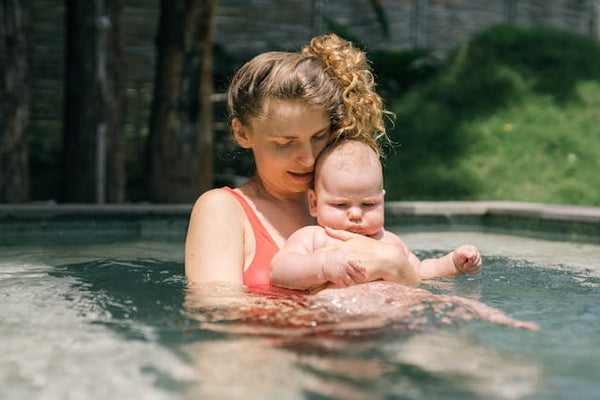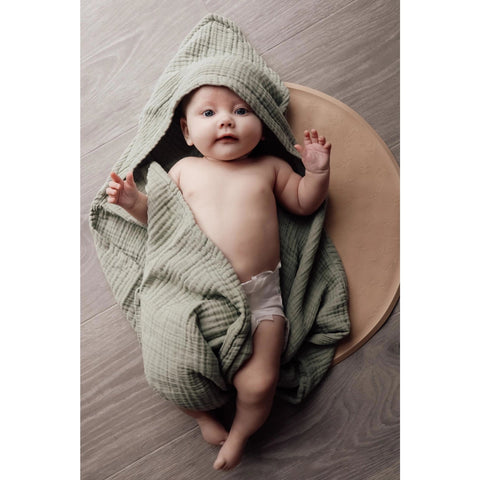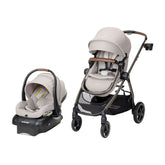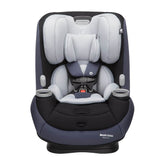Swim Lessons for Babies: What to Know and When to Start

According to the Centers for Disease Control, drowning is a leading cause of death among children. In fact, more American children ages one to four years die from drowning than any other cause of death except birth defects. Learning to swim is an important life skill that can help prevent drowning. Both children and their parents need to learn how to swim to stay safe and have fun in the water.
When it comes to babies and swim lessons, the American Academy of Pediatrics (AAP) has some specific recommendations on when to start swim lessons and what to look for in a good learn-to-swim program.
What Is the Best Age for a Baby to Start Swimming?
The AAP recommends swim lessons as early as one year of age to offer an additional layer of protection against drowning. That said, every child grows and develops at a different rate, so there’s no one age that’s right or wrong for everyone. When deciding whether your child is ready, consider their developmental limitations and abilities, emotional maturity, and comfort level with the water.
New evidence shows swim lessons and water survival skills training may help decrease the risk of drowning for children aged one to four years. Combined swimming lessons for mom and baby are a great way to present good water safety practices and begin preparing children for swim readiness skills. If your little one seems developmentally ready, this is a good age to begin.
Swim lessons are appropriate for almost all children by age four. At this stage, children can understand and perform basic water survival skills, like floating and getting to the edge of the pool. Around age five or six, most little ones can swim a front crawl. Swim lessons by this age are a must.
Should Infants Take Swim Lessons? When Should I Start Teaching My Baby to Swim?
The AAP does not recommend swim lessons for infants less than one year old. Currently, there is no evidence showing these programs reduce the risk of drowning for babies younger than 12 months. Though some babies may exhibit swim-like movements when placed in the water, these are simply reflexive. Many infants this age cannot properly raise their heads out of the water enough to breathe well. It is, however, a good opportunity to enroll in a parent-baby water safety course as a bonding experience and to acclimate your baby to the pool.
Remember: Swim Lessons Don’t Equal “Drown-Proof”
Drowning prevention requires a multi-layered approach. While swim lessons are a very important layer of protection, swim lessons alone aren’t enough. Steady, attentive surveillance when your baby is in any body of water is an essential part of water safety. Drowning prevention also depends on properly restricting access to pools, outside bodies of water, and indoor water areas (like bathtubs and washing machines) during times a child is not expected to be in the water.

What Is the Best Way to Introduce a Baby to Swimming?
Swim lessons for very young children should focus on basic water survival, not simply learning swim strokes. At a minimum, children should be taught how to get to the surface, push themselves at least 25 yards, and exit the water. A good swim teacher will assess your baby’s skills and provide feedback on their progress.
Things to Look for When Choosing Swim Lessons for Babies
Regardless of your child’s age, look for a program that does the following:
- Has qualified teachers. Look for swim teachers who’ve had training and certification through a nationally recognized swim program. CPR and first aid-certified lifeguards should be on duty as well.
- Mandates multiple lessons. Consistency is important when building swim skills. Children develop progress over time.
- Allows parents to observe a class first to see if it’s a good match for their child. Every program is different. Do the teachers seem patient? Are they knowledgeable? Do the children receive individualized attention? Are they having fun?
- Instructs children on good water safety habits. Instructors should teach children to never approach the water without a grown-up and to request permission before entering any body of water.
- Prepares children for what to do if they fall in the water. Lessons should train children in self-rescue, as well as instruction on how to handle a variety of possible scenarios, like swimming in clothes or falling in.
For babies and toddlers less than four years of age, look specifically for a program that also does the following:
- Maintains vigilant pool sanitation. Younger children and babies are more likely to ingest pool water. The class should also require suits with snug-fitting legs to minimize the risk of bodily waste in the pool.
- Practices “touch supervision.” Babies and young children should never be more than an arm’s length away from their supervising adult, even during swim lessons. Parent participation is especially helpful for children at this age since it helps set the stage early for good water safety habits and behavioral expectations.
- Provides a friendly, secure environment. Your baby should feel safe with fun, age-appropriate activities that support their growth while still establishing a healthy attitude of respect for the water.
- Warms the water. Water heated to 87 to 94 degrees Fahrenheit is ideal for children under the age of three, as they are at an increased risk for hypothermia.

Natruba Muslin Baby Hooded Bath Towel
How Do I Prepare My Baby for the First Swim? Making Baby Swimming Lessons Go Smoothly
Every child responds differently to swim lessons so be prepared for anything from excitement to a complete meltdown. Consistency and making it fun are the keys to success when it comes to babies in the water. Here are a few ways to keep your baby safe and happy during their swim lessons:
- Start prepping them at bathtime. Let your baby splash around and get used to having water on their face. Gently lay them back on their back in the tub (supervised, obviously) and let them adjust to the sensation. Add some bath toys and let them get a little noisy. Keep it fun.
- Avoid food just prior to class. To avoid an upset tummy in the pool, feed them a light, easily digestible snack (like fruit) at least an hour ahead of the lesson, then something more substantial afterward.
- Keep your baby happy before class. A baby who is grumpy because they’re overly tired or who is upset and crying probably won’t have a successful swim session.
- Get there early. Arriving at least ten minutes ahead of class time gives your baby a chance to calmly adjust to their surroundings instead of rushing in at the last minute.
The Bottom Line on Infant Swim Lessons
Once they’re ready for them, swim lessons for babies are an invaluable investment in your child’s future. They’re also a critical part of drowning prevention. Consult your pediatrician if you’re unsure whether your baby is developmentally ready for swim lessons, and start looking for a quality class for your family.
Looking for ways to teach them that the water can be fun? Take a look at this amazing pool and beach gear!










